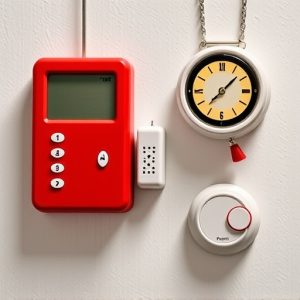Lone Worker Safety: Essential Tools & Best Practices for Alert Systems
Lone workers face safety risks like isolation and unexpected emergencies with limited communication……..
Lone workers face safety risks like isolation and unexpected emergencies with limited communication. A compact personal alarm device, with a decibel level above 100 dB, is crucial for distress signaling in diverse scenarios like remote construction sites or forest monitoring. When choosing such a device, prioritize durability, versatility (including water resistance), long battery life, user-friendly activation, and multiple alarm sounds. Implement a safety alert system through comprehensive risk assessment, easy accessibility, clear instructions, regular training, and a robust communication network for immediate follow-up after an alert.
Lone workers, whether they’re construction professionals, delivery drivers, or remote field researchers, face unique safety challenges. Unforeseen hazards can emerge without the immediate support of colleagues, underscoring the crucial need for effective safety alert systems. This article explores the critical role these systems play in mitigating risks and offers insights into choosing the best solution, focusing on the essential features of a loudest compact personal alarm device. We’ll also delve into best practices for implementation to ensure maximum protection for solo workers across diverse industries.
- Understanding the Risks of Lone Worker Safety
- Key Features to Consider in a Compact Personal Alarm Device
- Best Practices for Implementing and Using Safety Alert Systems
Understanding the Risks of Lone Worker Safety
Lone workers, by definition, operate without immediate supervision or support, which exposes them to unique safety risks. These risks can vary widely depending on the industry and specific tasks involved, but they often include isolation, unexpected emergencies, or dangerous situations with limited means of communication or assistance. For instance, a lone worker in a remote construction site faces different challenges than someone monitoring environmental sensors in an isolated forest area.
Given this diverse range of scenarios, implementing effective safety alert systems is paramount. A compact personal alarm device that produces the loudest sound can serve as a critical lifeline in such situations. These devices, designed for portability and ease of use, allow lone workers to promptly signal distress or danger, ensuring they’re not only heard but also quickly located by emergency services or colleagues.
Key Features to Consider in a Compact Personal Alarm Device
When selecting a compact personal alarm device, several key features stand out as essential for lone workers’ safety. One of the most critical aspects is decibel level; the loudest Compact Personal Alarm Device available ensures maximum audibility in case of an emergency. High-quality alarms should surpass 100 decibels to effectively penetrate noise from work environments or natural surroundings, guaranteeing that the alarm’s sound reaches nearby individuals or emergency services promptly.
Additionally, these devices should be versatile and durable, designed for various outdoor conditions. Water resistance and impact resilience are must-haves, as workers may need to activate the alarm in harsh environments. Features like long battery life, easy activation mechanisms, and multiple alarm sounds further enhance their effectiveness.
Best Practices for Implementing and Using Safety Alert Systems
When implementing a safety alert system for lone workers, it’s crucial to begin with a comprehensive assessment of their specific needs and work environments. Identify potential risks and hazards unique to each individual’s tasks. This process ensures that the chosen safety alert system is tailored to address those very risks. For instance, in remote or isolated areas, a loudest compact personal alarm device can be invaluable for quickly attracting attention in emergencies.
Best practices include ensuring easy accessibility of the devices, providing clear instructions on their use, and conducting regular training sessions to familiarize workers with both the hardware and the associated alert protocols. Additionally, establishing a robust communication network allows for immediate follow-up once an alert is triggered, enhancing overall safety measures.
Lone workers face unique safety challenges, but with the right tools, these risks can be mitigated. A loudest compact personal alarm device, equipped with essential features like GPS tracking and automatic fall detection, is crucial for enhancing visibility and response times in emergencies. Implementing best practices, such as regular training and clear communication protocols, ensures that safety alert systems are used effectively. By adopting these measures, we can foster a safer environment for lone workers and promote peace of mind for those who support them.


